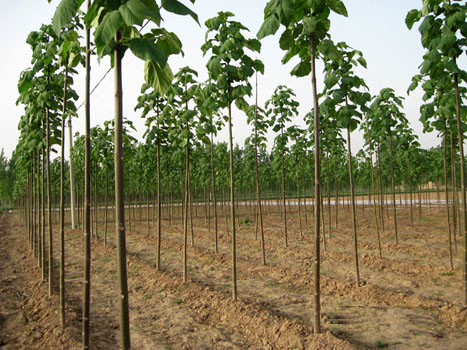Initial Planting Density of Paulownia Afforestation
The initial planting density refers to density of the first time afforestation (which means the individual spacing of Paulownia). How to design the initial planting density of Ppaulownia is not only related to the overall quality of Paulownia artificial forest, but also to the production cost, timber quality and etc.
Lands for Paulownia afforestation include plains with favorable natural conditions, semi-arid areas with heavy sandstorm and bad water & fertilizer conditions, gentle slope hills and shallower mountain areas with different site conditions.
Based on growth characteristics of Paulownia, different afforestation methods shall be utilized for different site conditions and climate. Afforestation methods for various species of seedlings are also different from each other. Proper selection of seedling and method for afforestation according to different site conditions and climate is a comprehensive technical measure for afforestation program, which is related to the survival rate, growth of sapling and input cost.

In the period following the afforestation until trees growing into a forest, sapling of Paulownia require more tending management and labor-intensive due to having not formed their own forest climate which suitable for their growth and easy to be affected by climate, soil, vegetation, animal, disease & insect pest and human behavior. In order to make trees have a higher survival rate and grow fast which in good manners and reduce production inputs of this period, sapling shall be cultivated into a forest as early as possible. Thus designing a reasonable initial planting density should be taken as an important technique measure for Paulownia growing into a forest as soon as possible.
1 – 2 years after afforestation, some of saplings will die due to various natural and human factors. Then, crown of the sapling in normal growth will grow towards the open areas formed by the dead sapling to compete for sunlight and the flat crown will be grown up resulting in bending of the trunk, which will not only reduce the timber output, but also lower the timber quality. Because of this, if the initial planting density is too small, number of trees for cutting will be reduced. So, only the rational close-planting is an essential safeguard to increase the survival rate of Paulownia.
In 1970s and 1980s, the initial planting density of Paulownia artificial forest is relatively small. 1-2 years after afforestation, complementary seedlings will be planted in the area where short of seedlings. But it proved that the complementary seedlings will not grow as tall and wide as the former plants because of the shade formed by former Paulownia and it is easy for these plants to grow up into underdeveloped trees (namely trees can only survive but can not grow up) with weak growing trend and easy access to be infected by diseases, which will also infect other healthy trees leading to unnecessary losses. So the initial planting density shall be designed in a proper manner by which all seedlings shall be planted in one time without any complementary seedlings. When the forest coming into being, intermediate cuttings could be implemented that the timber can be sold as commodity (a way to collect all investment in the early period) and harvest cutting density (number of plants finally cut for one time per unit area) can be maintained as well, which will realize maximization of the economic bebefit.
According to different Paulownia species, site conditions, afforestation types and afforestation purposes, the initial planting density of Paulownia could be designed in the following individual spacing: 2×3m, 3×3m, 3×4m, 4×5m, 5×5m, 5×6m, 6×8m, 5×10m, 5×30m, 5×50m and etc.
